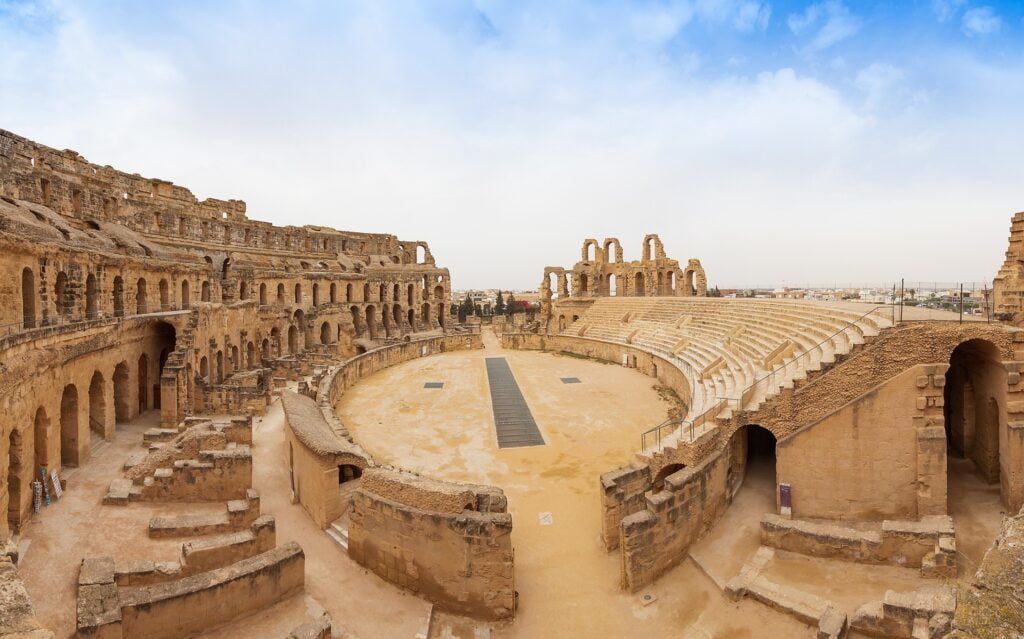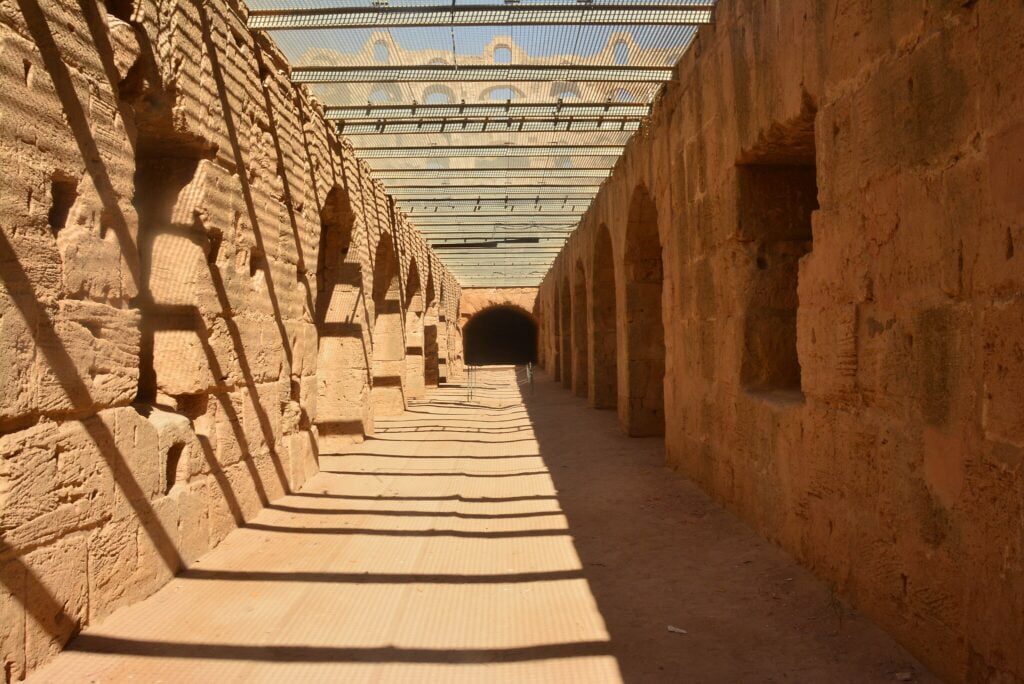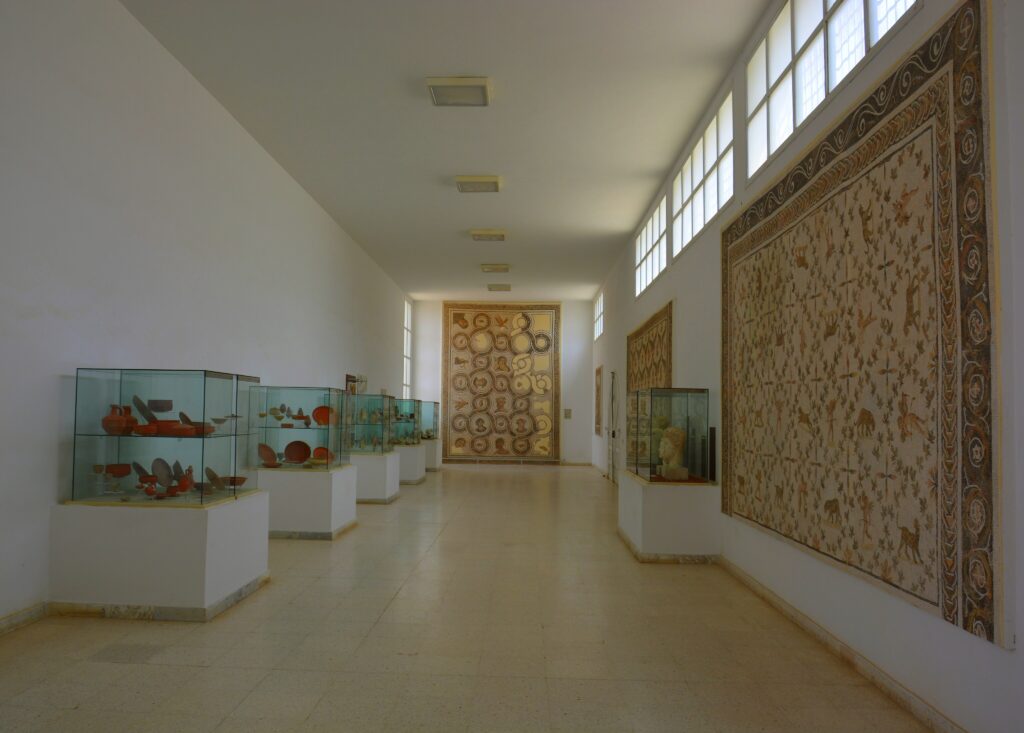Introduction
The Amphitheatre of El Jem, a site of immense historical significance, is an awe-inspiring ancient Roman theater in Tunisia. Renowned as one of the world’s best-maintained Roman stone remains, it has been designated a UNESCO World Heritage site. The area could accommodate up to 35,000 people and was a lively spot for gladiator battles and other public events. More than just a relic of the past, it is a direct connection to our history, allowing us to tangibly experience the grandeur and architectural skill of the Roman Empire and inviting you to be a part of this historical journey.
Table of Contents
Where is the Amphitheatre of El Jem located?

The Amphitheatre of El Jem is in the present-day city of El Djem, Tunisia, in the East-central region of Tunisia, North Africa. It was once known as Thysdrus in the Roman province of Africa. Among the most well-maintained Roman theaters globally, this arena is open for visitors to explore and witness its grandeur. The site is regularly maintained to ensure its preservation and is open to the public most of the year. It is easily accessible by road and public transport, making it a convenient destination for history and architecture enthusiasts.
Inscription of the Amphitheatre of El Jem
The Amphitheatre of El Jem, a UNESCO World Heritage Site since 1979, is a testament to the remarkable Roman architectural and engineering prowess. Its immense size and oval shape vividly illustrate the magnificence of Roman culture in Africa. But its historical and cultural significance goes beyond its grandeur. This site is a living testament to the Roman Empire’s presence in North Africa and its pivotal role in disseminating Roman architectural techniques throughout the region.
The theater’s inscription as a UNESCO World Heritage Site underscores its exceptional universal value. It represents the extent of the Roman Empire’s influence and architectural heritage in Tunisia. It’s a direct link to our past, inviting you to explore and connect with the rich history and culture of the Roman Empire.
What is the history of the Amphitheatre of El Jem?
The remains of the biggest Colosseum in North Africa, an expansive amphitheater capable of accommodating 35,000 people, can be seen in the tiny town of El Jem. This structure from the 3rd century demonstrates the magnificence and scale of Ancient Rome. The Amphitheatre of El Jem stands out as one of the most exceptional monuments of its type and is unparalleled in Africa.
Its unique feature of being situated on level ground and upheld by a sophisticated network of arches instead of being constructed against a hillside is a testament to the Roman Empire’s engineering prowess. This fact alone will surely leave you in awe. The building of an advanced and intricate structure in a distant region intended for public events reflects the propaganda of the imperial Romans.
Architectural of the Amphitheatre of El Jem

Situated in a flat expanse at the heart of Tunisia, this theater is built exclusively from stone blocks, without foundations, and stands independently. The Amphitheatre of El Jem’s location in a flat expanse was a strategic choice, allowing for the construction of a large, open-air theater without requiring extensive excavation or structural support. This location also provided a clear view of the entire structure, enhancing the audience’s experience.
The Amphitheatre of El Jem offers remarkable evidence of Roman architectural expertise, particularly in constructing African entertainment venues. In this regard, it is designed based on the Coliseum of Rome, which is not a precise replica of the Flavian structure. With a significant axis of 148 meters, a minor axis of 122 meters, and a capacity of 35,000 spectators, it is unquestionably one of the largest theaters globally. The front of the building consists of three tiers of Corinthian or composite-style arches.
Most of the structure supporting the tiered seating has been preserved. The wall at the base, the central area, and the underground pathways are in almost original condition. This impressive architectural and artistic structure was constructed around 238 AD, marking a significant point in comprehending the history of Roman Africa. The Amphitheatre of El Jem is evidence of the affluence of the ancient city of Thysdrus (present-day El Jem) during the Roman Empire.
Where is the Al Jem Museum? What is the Al Jem Museum Famous for?

The El Jem Museum, located near the renowned Amphitheatre of El Jem, is a significant archaeological museum in Tunisia. Its focus is on presenting the abundant Roman history of the area, precisely that of the ancient city of Thysdrus (now known as El Jem). The museum exhibits various artifacts, providing insight into North Africa’s Roman-era life. It is a cultural link connecting guests to the illustrious Roman history of Thysdrus, a pivotal city in Roman Africa. For individuals interested in Roman history, architecture, and art, the El Jem Museum provides a priceless view of ancient times’s daily life and magnificence, making it a must-visit for a comprehensive understanding of the Amphitheatre of El Jem.
Preservation of the Amphitheatre of El Jem
Preserving the Amphitheatre of El Jem is crucial due to its historical and cultural significance. As one of the world’s best-preserved Roman stone remains and a UNESCO World Heritage site, efforts to maintain and protect this ancient structure are ongoing. Regular maintenance ensures the theater’s preservation and the site is open to the public to explore and appreciate its grandeur.
The Amphitheatre of El Jem serves as a living testament to the architectural and engineering prowess of the Roman Empire and provides visitors with a tangible connection to the past. Efforts to safeguard and conserve this remarkable historical site are essential to continue providing future generations with the opportunity to experience the grandeur and cultural importance of the Roman Empire in North Africa.
Why should you visit, and what advantage do you get as a visitor from the Amphitheatre of El Jem?

The Amphitheatre of El Jem, also known as the Thysdrus Amphitheatre, is a remarkable UNESCO World Heritage site in Tunisia. As a visitor, you will have the advantage of experiencing one of the world’s largest and best-preserved Roman theaters. The splendor and historical significance of this ancient amphitheater offer a fascinating glimpse into the past, allowing you to immerse yourself in the rich history of the Roman Empire.
Additionally, the site provides a stunning backdrop for photography enthusiasts and offers a unique opportunity to appreciate antiquity’s architectural and engineering marvels. Whether you are a history buff, an architecture enthusiast, or simply a traveler with a penchant for extraordinary sights, visiting the Amphitheatre of El Jem promises an enriching and awe-inspiring experience.




